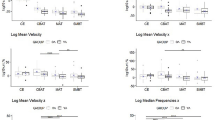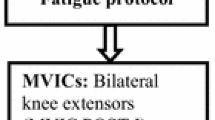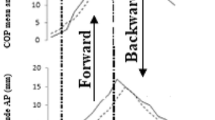Abstract
Purpose
The aim of the present study was to investigate the effects of muscular fatigue on the interaction between posture and movement during a lower limb pointing task.
Methods
Participants (n = 16), aged 18–30 years, kicked a ball toward a target in four conditions of fatigue: No muscular fatigue (NF), fatigue in the kicking (FM) or postural limb (FP) alone, and fatigue in both limbs (FMP). The mean amplitude and speed of the centre of foot pressure (CoP) and centre of mass (CoM) displacements were estimated through a force platform and an optoelectronic system, respectively. In addition, surface electromyography (EMG) of the biceps femoris, rectus femoris, medial gastrocnemius, and peroneus longus was recorded to investigate the anticipatory postural adjustments (APAs).
Results
Muscular fatigue yielded a decreased kicking accuracy (p < 0.001) and an increased time to perform the movement (p < 0.001), mainly during the backswing motion. In addition, significant increases in the mean amplitude and speed of the CoP and CoM displacement were found in the anteroposterior (AP) and mediolateral (ML) axes (ps < 0.001), especially when both limbs were fatigued. The EMG analysis confirmed that fatigue modified the way APAs were generated. During fatigue, postural muscle activity increased, but was delayed with respect to movement onset (ps < 0.001). This pattern of response was more consistent when both limbs were fatigued (p < 0.001).
Conclusion
The present results suggested an additive effect of fatigue and a functional adaptation and subsequent decrease in the overall variability of APAs, indicating that postural and motor processes are interdependent.





Similar content being viewed by others
Abbreviations
- ANOVA:
-
Analysis of variance
- AP:
-
Anteroposterior
- APAs:
-
Anticipatory postural adjustments
- BF:
-
Biceps femoris
- CNS:
-
Central nervous system
- CoM:
-
Centre of mass
- CoP:
-
Centre of pressure
- EMG:
-
Electromyography
- FM:
-
Fatigue of the motor limb
- FMP:
-
Fatigue of the motor and postural limb
- FP:
-
Fatigue of the postural limb
- GM:
-
Medial gastrocnemius
- ML:
-
Mediolateral
- NF:
-
No fatigue
- PL:
-
Peroneus longus
- RF:
-
Rectus femoris
- SENIAM:
-
Surface EMG for non-invasive assessment of muscles
- 3 D:
-
Three dimensional
References
Apriantono T, Nunome H, Ikegami Y, Sano S (2006) The effect of muscle fatigue on instep kicking kinetics and kinematics in association football. J Sport Sci 24(9):951–960. https://doi.org/10.1080/02640410500386050
Aruin AS, Latash ML (1995a) Directional specificity of postural muscles in feedforward postural reactions during fast voluntary arm movements. Exp Brain Res 103(2):323–332. https://doi.org/10.1007/bf00231718
Aruin AS, Latash ML (1995b) The role of motor action in anticipatory postural adjustments studied with self-induced and externally triggered perturbations. Exp Brain Res 106(2):291–300. https://doi.org/10.1007/bf00241125
Beilock SL, Carr TH, MacMahon C, Starkes JL (2002) When paying attention becomes counterproductive: impact of divided versus skill-focused attention on novice and experienced performance of sensorimotor skills. J Exp Psychol Appl 8(1):6–16. https://doi.org/10.1037//1076-898x.8.1.6
Berger LL, Regueme SC, Forestier N (2010) Unilateral lower limb muscle fatigue induces bilateral effects on undisturbed stance and muscle EMG activities. J Electromyogr Kinesiol 20(5):947–952. https://doi.org/10.1016/j.jelekin.2009.09.006
Borg G (1990) Psychological scaling with applications in physical work and the perception of exertion. Scand J Work Environ Health 16(Suppl 1):55–58. https://doi.org/10.5271/sjweh.1815
Cifrek M, Medved V, Tonković S, Ostojić S (2009) Surface EMG based muscle fatigue evaluation in biomechanics. Clin Biomech (Bristol, Avon) 24(4):327–340. https://doi.org/10.1016/j.clinbiomech.2009.01.010
Fourcade P, Hansen C, LeBozec S, Bouisset S (2014) Simultaneous postural adjustments (SPA) scrutinized using the Lissajous method. J Biomech 47(15):3645–3649. https://doi.org/10.1016/j.jbiomech.2014.10.004
Gimmon Y, Riemer R, Oddsson L, Melzer I (2011) The effect of plantar flexor muscle fatigue on postural control. J Electromyogr Kinesiol 21(6):922–928. https://doi.org/10.1016/j.jelekin.2011.08.005
Gribble PA, Hertel J (2004) Effect of hip and ankle muscle fatigue on unipedal postural control. J Electromyogr Kinesiol 14(6):641–646. https://doi.org/10.1016/j.jelekin.2004.05.001
Hart NH, Nimphius S, Piteri T, Newton RU (2014) Leg strength and lean mass symmetry influences kicking performance in Australian football. J Sports Sci Med 13(1):157–165
Hilt PM, Berret B, Papaxanthis C, Stapley PJ, Pozzo T (2016) Evidence for subjective values guiding posture and movement coordination in a free-endpoint whole-body reaching task. Sci Rep 6:23868. https://doi.org/10.1038/srep23868
Kanekar N, Aruin AS (2015) Improvement of anticipatory postural adjustments for balance control: effect of a single training session. J Electromyogr Kinesiol 25(2):400–405. https://doi.org/10.1016/j.jelekin.2014.11.002
Kanekar N, Santos MJ, Aruin AS (2008) Anticipatory postural control following fatigue of postural and focal muscles. Clin Neurophysiol 119(10):2304–2313. https://doi.org/10.1016/j.clinph.2008.06.015
Katis A, Giannadakis E, Kannas T, Amiridis I, Kellis E, Lees A (2013) Mechanisms that influence accuracy of the soccer kick. J Electromyogr Kinesiol 23(1):125–131. https://doi.org/10.1016/j.jelekin.2012.08.020
Kellis E, Katis A (2007) Biomechanical characteristics and determinants of instep soccer kick. J Sports Sci Med 6(2):154–165
Kennedy A, Guevel A, Sveistrup H (2012) Impact of ankle muscle fatigue and recovery on the anticipatory postural adjustments to externally initiated perturbations in dynamic postural control. Exp Brain Res 223(4):553–562. https://doi.org/10.1007/s00221-012-3282-6
Ledin T, Fransson PA, Magnusson M (2004) Effects of postural disturbances with fatigued triceps sural muscles or with 20% additional body weight. Gait Posture 19(2):184–193. https://doi.org/10.1016/S0966-6362(03)00061-4
Mapelli A, Zago M, Fusini L, Galante D, Colombo A, Sforza C (2014) Validation of a protocol for the estimation of three-dimensional body center of mass kinematics in sport. Gait Posture 39(1):460–465. https://doi.org/10.1016/j.gaitpost.2013.08.025
Massion J (1992) Movement, posture and equilibrium: interaction and coordination. Prog Neurobiol 38(1):35–56. https://doi.org/10.1016/0301-0082(92)90034-c
Massion J, Alexandrov A, Frolov A (2004) Why and how are posture and movement coordinated? Prog Brain Res 143:13–27. https://doi.org/10.1016/S0079-6123(03)43002-1
Monjo F, Forestier N (2014) Unexperienced mechanical effects of muscular fatigue can be predicted by the Central Nervous System as revealed by anticipatory postural adjustments. Exp Brain Res 232(9):2931–2943. https://doi.org/10.1007/s00221-014-3975-0
Pau M, Mereu F, Melis M, Leban B, Corona F, Ibba G (2016) Dynamic balance is impaired after a match in young elite soccer players. Phys Ther Sport 22:11–15. https://doi.org/10.1016/j.ptsp.2016.05.008
Remaud A, Boyas S, Caron GA, Bilodeau M (2012) Attentional demands associated with postural control depend on task difficulty and visual condition. J Mot Behav 44(5):329–340. https://doi.org/10.1080/00222895.2012.708680
Rios JL, Gorges AL, Santos MJ (2015) Individuals with chronic ankle instability compensate for their ankle deficits using proximal musculature to maintain reduced postural sway while kicking a ball. Hum Mov Sci 43:33–44. https://doi.org/10.1016/j.humov.2015.07.001
Robert G, Blouin J, Ruget H, Mouchnino L (2007) Coordination between postural and movement controls: effect of changes in body mass distribution on postural and focal component characteristics. Exp Brain Res 181(1):159–171. https://doi.org/10.1007/s00221-007-0916-1
Santos MJ, Aruin AS (2008) Role of lateral muscles and body orientation in feedforward postural control. Exp Brain Res 184(4):547–559. https://doi.org/10.1007/s00221-007-1123-9
Shiratori T, Latash ML (2001) Anticipatory postural adjustments during load catching by standing subjects. Clin Neurophysiol 112(7):1250–1265. https://doi.org/10.1016/s1388-2457(01)00553-3
Shumway-Cook A, Woollacott M (2000) Attentional demands and postural control: the effect of sensory context. J Gerontol A Biol Sci Med Sci 55(1):M10-16. https://doi.org/10.1093/gerona/55.1.m10
Strang AJ, Berg WP (2007) Fatigue-induced adaptive changes of anticipatory postural adjustments. Exp Brain Res 178(1):49–61. https://doi.org/10.1007/s00221-006-0710-5
Winter DA (1990) Biomechanics and motor control of human movement. John Wiley, New York, NY
Acknowledgements
CAPES scholar—Process number BEX 14828/13-8. The authors would like to thank the participants and the anonymous reviewers for helpful comments and suggestions. Special thanks also are extended to Guillaume Chauvel for various contributions.
Author information
Authors and Affiliations
Corresponding author
Ethics declarations
Conflict of interest
The authors declare that the research was conducted in the absence of any commercial or financial relationships that could be construed as a potential conflict of interest.
Ethical approval
All procedures performed in studies involving human participants were in accordance with the ethical standards of the Ethics Committee (STAPS/FRA nº 2014-01-12-6) and with the 1964 Helsinki declaration and its later amendments.
Additional information
Communicated by Peter Krustrup.
Publisher's Note
Springer Nature remains neutral with regard to jurisdictional claims in published maps and institutional affiliations.
Rights and permissions
About this article
Cite this article
Silva, M.G., Struber, L., Daniel, O. et al. Effects of a lower limb muscular fatigue on posture–movement interaction during a lower limb pointing task. Eur J Appl Physiol 121, 287–295 (2021). https://doi.org/10.1007/s00421-020-04529-9
Received:
Accepted:
Published:
Issue Date:
DOI: https://doi.org/10.1007/s00421-020-04529-9




